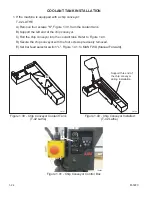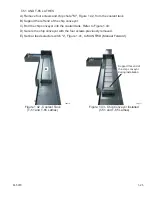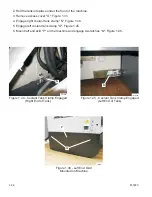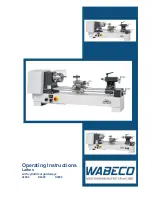
COOLANT
- CAUTION -
Whenever cutting fluids are used, it is essential to follow the manufacturer’s rec-
ommendations on the selection and maintenance for that particular fluid.
- NOTE -
A properly selected and maintained coolant, either oil or water based, will ensure
the best performance from the coolant and machine.
Hardinge machine tools are designed using the latest technology and highest quality materials
available. However, due to the ever increasing number of cutting fluid (coolant) selections available, it
is impossible to test material compatibility with each and every coolant. Refer to the maintenance
manual (M-506) and the coolant pump instruction booklet for information regarding the coolant sys-
tem on this machine. The two most popular types of cutting fluids are cutting oils and water-based
coolants.
WATER-BASED COOLANTS
Water-based coolants are a cutting fluid which, when improperly specified or maintained, can af-
fect the life of a machine and the quality of the parts produced. Water-based coolants are designed to
suppress rusting, enhance cutting, increase tool life, promote heat dissipation, and be economical to
use.
Some water-based coolants may cause machine corrosion problems and be incompatible with ma-
chine components, especially if the fluid is not maintained correctly. Poorly maintained coolants may
result in rancidity, poor tool life, staining, rusting, and foaming; which affect machine performance and
may cause health problems such as dermatitis. Water-based coolants must be correctly specified ac-
cording to the machined materials and to ensure compatibility with the machine’s components. Refer
to the list of common materials used in the manufacture of Hardinge machines, on page 1-41.
It is extremely important to follow the coolant manufacturer’s recommendations when using a wa-
ter-based coolant. Maintaining coolants per the manufacture’s recommendations will increase the
machine’s useful life and will minimize corrosion, rusting, staining, and health problems such as der-
matitis. At a minimum, the coolant maintenance should include daily checks and correction of coolant
concentration and a measure of coolant pH.
FILLING THE COOLANT TANK
- WARNING -
Spilling fluid on the floor can create a slipping hazard. Spilled fluid must be
cleaned up immediately.
Pour the coolant directly into the chip pan of the coolant tank. Fill the coolant tank to 1 inch [25 milli-
meters] above the chip screen.
The approximate coolant tank capacity is:
T-42 lathe without chip conveyor:
55 gallons [208 liters]
T-42 lathe with chip conveyor:
50 gallons [189 liters]
T-51 and T-65 lathes:
65 gallons [246 liters]
M-507C
1-33
Summary of Contents for T-42
Page 8: ... NOTES vi M 507C ...
Page 50: ... NOTES 1 42 M 507C ...
Page 84: ... NOTES 2 34 M 507C ...





































